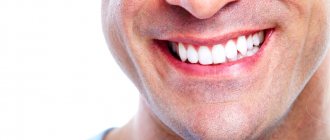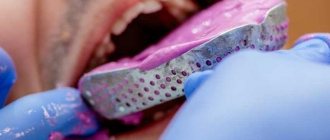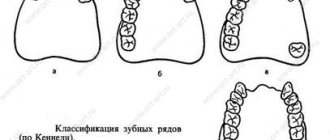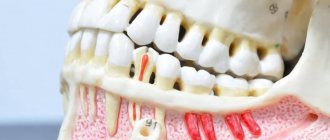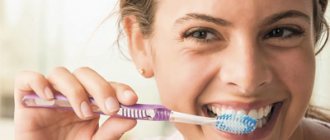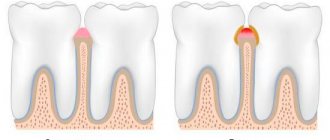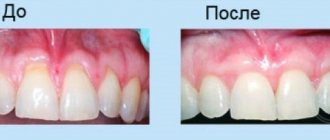Prevention
- Primary: prevention of dental diseases by eliminating the causes and conditions of their occurrence, as well as increasing the body’s resistance to adverse factors.
- Secondary: a set of measures aimed at preventing relapses and complications of diseases.
- Tertiary: a system of measures aimed at the rehabilitation of dental status by preserving the functionality of organs and tissues of the maxillofacial area, mainly by replacement.
Preventive measures are beneficial to everyone without exception. They are especially needed by patients suffering from endocrine diseases, pregnant women, and people with bad habits.
Basic principles of prevention of periodontitis and periodontal disease
- Proper oral care.
- Regular visits to the dentist.
- Healthy eating.
- Sanitation of chronic foci of infection.
- Rejection of bad habits.
As you can see, the principles are known to everyone, they are simple and easy to implement. You just need to not be lazy and stick to them. Prevention of periodontal diseases can be local and general. Let us dwell in more detail on each principle of prevention.
Proper oral care for periodontal prevention
One of the main preventative measures to avoid periodontitis is careful oral care. If you follow basic rules, you can avoid problems with teeth, because the effectiveness of this method is close to 100%.
Now in pharmacies you can buy various auxiliary products for high-quality oral hygiene - irrigators, flosses, devices for cleaning the tongue, rinses, gel-pastes, sprays, individual special mirrors for teeth, chewing gum with various additives, care products for removable orthopedic and orthodontic designs and even safe, but very indicative dyes for identifying plaque at home. You can easily choose for yourself what you like best and is better suited for oral hygiene.
1. Brushing your teeth.
It is necessary to teach a child from an early age to brush their teeth correctly:
- Teeth should be brushed at least twice a day after meals, and even better after each meal;
- cleaning time should be up to two minutes;
- the movements of the brush should be as if cleaning.
2. Choosing the right toothbrushes.
The effect of brushing your teeth depends on the choice of toothbrush. Nowadays you can buy toothbrushes with different options. There are brushes that can be used to massage your gums while brushing your teeth. The height of the bristles can be different and provide cleaning in hard-to-reach places and between teeth. There are brushes that can clean your tongue. There are brushes with different thicknesses of bristles and with different numbers of rows, there are brushes with synthetic bristles and natural bristles, with different head sizes. There are even brushes that whiten teeth! What are the best, how to choose the right toothbrush?
The toothbrush is selected on the advice of the dentist. The doctor takes into account the condition of the gums and recommends a certain stiffness of the bristles. Usually a brush with medium-hard bristles is chosen; if the gums are easily injured and bleed, then use soft bristles.
Remember!
- the brush must be changed every 2-3 months, since its bristles wear off, plus microbes accumulate in it, and it becomes a breeding ground for infection throughout the mouth;
- after an infection, the brush should be changed in any case;
- after each brushing of your teeth, the brush should be thoroughly washed under running water, preferably with soap;
- the toothbrush should not be stored wet or in contact with other brushes;
- Toothbrushes should be stored with the head up, and not in cases;
- You should choose a brush with a rounded head so as not to injure the oral mucosa;
- It is better to purchase a toothbrush in pharmacies.
Electric toothbrushes represent a separate category. When using them, vibration movements are performed, thereby more thoroughly removing plaque from the teeth. Brushes can be powered by batteries. But with periodontal diseases, dentists do not recommend using electric toothbrushes. There are also sonic, ultrasonic, ionic and acoustic toothbrushes. They are not so popular, reviews about them are mixed, but their capabilities and quality are improving every year and we can expect that the demand for them will only increase. After all, for example, ultrasonic toothbrushes can neutralize the surface of teeth using ultrasound.
3. Caring for your mouth after eating.
It is advisable to rinse your mouth after each meal (if you cannot brush your teeth) and use additional personal hygiene products:
- floss (dental floss) is used to clean narrow interdental spaces before brushing your teeth, but only after consultation with a doctor who will evaluate the condition of your mouth; floss can injure sensitive areas of the gums, so many dentists treat dental floss with caution;
- a toothpick helps remove food debris from the interdental spaces, but it must be handled very carefully; if there are periodontal phenomena, it is better to avoid using them;
- if there are large gaps between the teeth, then they can be cleaned well with a stream of irrigator or special brushes;
- It is very good to rinse your mouth with dental elixirs (especially at night), but the elixirs must be changed so that the microflora does not become accustomed to the medicinal components;
- be sure to purchase an irrigator, which is simply necessary for dental care; irrigators create a stream of water, the pressure of which you can choose yourself; look for an irrigator with different attachments - for gums, for cleaning the tongue, interdental spaces, braces. Thanks to regular use of the irrigator, the gums become stronger, tartar forms less frequently, and cleaning the tongue also helps reduce the number of bacteria in the oral cavity. The stream of the irrigator washes away food debris that gets stuck under bridges and braces.
- a good preventative measure for periodontal disease is hydromassage of the gums using an irrigator, simple massage with fingers or interdental stimulators (rubber cones), regular massage trains the vessels of the gums and strengthens the maxillofacial apparatus;
- use of high-quality chewing gum - chewing gum is the minimum that is necessary after brushing your teeth, if it is not possible to brush your teeth and rinse your mouth after eating;
4. Choosing the right toothpaste.
Toothpaste must be of high quality, so it is better to purchase it at a pharmacy. Nowadays, toothpastes have different effects due to the active components included in their composition - bactericidal, strengthening, preventing the formation of plaque, reducing the sensitivity of the necks of teeth, whitening, etc. When choosing toothpaste, it is better to listen to the advice of your dentist, who will give individual recommendations after examining your teeth.
Primary prevention of periodontal disease involves
- training in the basics of individual oral hygiene, monitoring the quality of its implementation;
- carrying out professional hygienic treatment of the oral cavity at certain intervals;
- elimination of violations of the architectonics of the soft tissues of the vestibule of the oral cavity, abnormal attachment of cords and frenulum (short cords and frenulum, small vestibule of the oral cavity);
- according to indications - timely orthodontic treatment in order to normalize the distribution of mechanical load on the teeth and at the same time - eliminate the conditions in which the activity of microbial influences increases.
It is primary prevention, its timely initiation and implementation on the required scale that allows us to solve the problem of periodontal diseases. Secondary and tertiary prevention are always strictly individual and depend on the existing consequences of the disease.
Forms of periodontitis in children
Depending on the age period, experts distinguish two forms of this disease in children:
- Prepubertal periodontitis
Characteristic of young children (up to 10 years), most often occurs during teething or immediately after this process is completed.
This form is asymptomatic, the child does not experience pain. A characteristic sign of the disease is a white coating on the teeth and gums and loosening of baby teeth. If treatment is not started as soon as possible, teeth will fall out much earlier than expected.
The danger is that there is severe destruction of the bone tissue around the teeth, and the pathological process begins to affect the rudiments of permanent teeth, which subsequently causes serious problems in their growth and development.
- Adolescent (pubertal) periodontitis
As the name suggests, it occurs during adolescence. With this form, the alveolar processes of the jaws are rapidly destroyed.
The child may complain of itching, swelling of the gums and fever, bad breath, and thick saliva. In later stages, pus begins to ooze from the periodontal pockets.
Oral hygiene
Individual oral hygiene is the main method of primary prevention of periodontal diseases:
- regular and proper brushing of teeth (3 times a day);
- using high-quality toothbrushes and toothpastes;
- the use of additional means of prevention (flosses, interdental brushes, irrigators, devices for cleaning the tongue, etc.).
Factors in choosing personal hygiene products
- age;
- the presence of dental diseases or a predisposition to them;
- individual characteristics of the oral cavity (atypical structure of the dentition and shape of the teeth, the presence of orthopedic or orthodontic structures in the oral cavity, etc.).
Prevention of hypersensitivity of dental tissues
About 62% of the adult population in Russia suffers from painful tooth sensitivity. Most often, increased sensitivity occurs when the necks of teeth are exposed due to periodontal disease. In addition, it can cause the development of periodontal diseases due to unsatisfactory tooth brushing due to the pain of its implementation. Special toothpastes, rinses, flosses and gels are used as therapeutic and prophylactic agents for increased dental hypersensitivity.
Elimination of local factors
A number of local factors contribute to increased accumulation of dental plaque. There are a number of such factors: cervical carious cavities; unrestored interdental contacts; overhanging edges of fillings; edges of artificial crowns deeply advanced under the gum; foci of demineralization of gingival surfaces; lack of equator of tooth crowns; wide and attached close to the gingival edge of the frenulum and strands of the mucous membrane; availability of orthodontic devices; close arrangement of teeth, etc. Therefore, timely elimination of the listed factors is a necessary component of the prevention of inflammatory periodontal lesions.
Elimination of supercontacts and functional selective grinding
The traumatic factor is one of the most significant. In the absence of physiological abrasion of the enamel tubercles, which is observed in 20-22% of the population, in order to prevent increased and uneven load on the periodontium, functional selective grinding is carried out.
Surgical elimination of deformation of the soft tissues of the oral vestibule
Correction of pulling cords, frenulums, and small vestibule of the oral cavity should be carried out before they have time to lead to destructive lesions. The optimal period is the school period, after the completion of the formation of the alveolar process.
Bite correction
Malocclusion affects the condition of the periodontium, usually due to uneven mechanical load on the periodontium. Therefore, correcting malocclusion in childhood has a significant preventive effect.
Prophylactic use of antiseptic drugs
When carrying out preventive measures, it is necessary to use antimicrobial drugs that affect periodontal pathogenic microflora. Some of the most effective agents are chlorhexidine and triclosan. The use of products containing these substances should be supervised by specialists.
Professional oral hygiene
Professional oral hygiene is an important point in the system of preventing inflammatory periodontal diseases. We use the following tools: scalers, air-abrasive systems (handy blasters), such as Air-Flow (EMS); abrasive polishing pastes.
Features of the treatment of periodontitis in children
If you suspect your child has periodontitis, contact a specialist immediately. Only doctors can confirm such a serious diagnosis and give recommendations for treating the disease.
In this case, first of all, it is necessary to identify the cause of the disease and, depending on this, take certain measures: correct the bite, teach the child to brush his teeth correctly, trim the frenulum, seal the teeth.
In addition to eliminating the cause of periodontitis, comprehensive treatment must be carried out, which must be prescribed by a doctor.
Do not forget that to prevent this dangerous disease, it is almost always enough to ensure that the child observes oral hygiene. The child should brush his teeth 2 times a day, brushing for at least 2 minutes. Don’t be lazy to control the process, observing how correctly it is proceeding. And be sure to make sure that the toothpaste is appropriate for the baby’s age, and the brush is changed every 3 months. To maintain dental health, use Asepta toothpastes from the Baby, Kids and Teens series. They carefully clean the enamel, saturate it with calcium, strengthen teeth and prevent the development of caries.
The benefits of our preventative procedures
- special attention to the condition of the oral cavity during pregnancy;
- strengthening gums with the help of professional procedures: therapeutic dressings, applications, coatings.
- individual selection of hygiene products;
- timely detection of the development of gum disease at an early stage, which facilitates the treatment process.
We hope that preventative measures will help you never experience gum disease. However, gum inflammation can occur against the background of certain body conditions:
- stress;
- hormonal changes: puberty, pregnancy, diseases of the internal secretion organs;
- diseases of the endocrine system - high levels of glucose in the blood (diabetes of any type); vascular diseases; gastrointestinal tract;
- problems with the absorption of certain vitamins and microelements;
- the presence of pathogenic microflora in the oral cavity.
In case of suspicion of serious disorders that played a role in the development of gum disease, Kuntsevo specialists give a referral for examination by doctors in other departments. A multidisciplinary approach to each patient allows not only to cope with the symptoms, but also to eliminate the underlying causes.
Kuntsevo dentists guarantee high quality of services provided. We not only relieve our patients of discomfort and relieve inflammation, but also fight the underlying causes that led to the development of the disease, which ensures lasting results and prevention of relapses.
Causes of periodontitis in children
- the most common is insufficient oral hygiene, which causes the proliferation of harmful bacteria in the baby’s mouth;
- abnormalities in the growth and development of teeth or jaw bones (for example, malocclusions) - in this case, the process of chewing food is disrupted, which leads to problems with the gums;
- the habit of chewing only on one side - in this case, the second half of the teeth is not cleared of food particles and a characteristic plaque appears on them;
- congenital defects in the structure of the lips, tongue, as well as a short frenulum - all of them provoke an increase in the number of harmful microorganisms in the oral cavity, since they negatively affect the chewing process;
- gum injuries - they can be caused by reasons such as the habit of biting nails or objects (pencils, pens), excessive consumption of hard foods.
